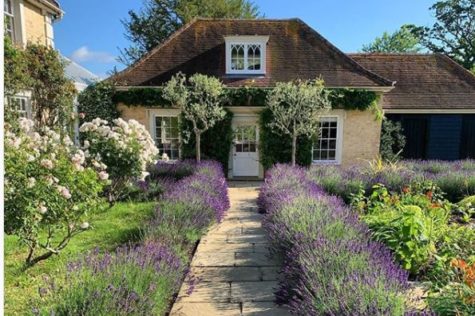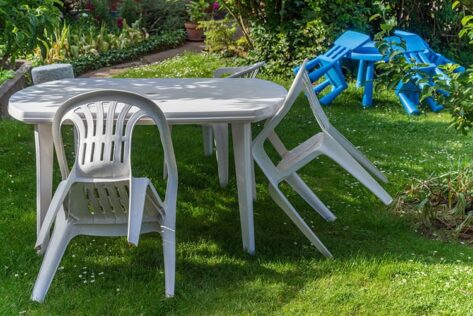There are so many wonderful ways you can bring sustainability and eco-friendliness into your garden; we’ve already talked about growing your own kitchen garden, and planting living walls and green roofs. Another fun project to help the eco-system is to build an insect house! We’ve got a whole bunch of cute, practical and artistic bug hotel ideas to suit gardens of every size and style.
Did you know that the average garden can accommodate more than 2,000 different insect species? Although there are a fair few pests, having the right bugs in your garden is such a benefit. Encouraging friendly species like bees, ladybirds, and beetles not only helps to pollinate your flowers, but can actually help you control the numbers of pesky plant-eaters.
So, if you fancy an easy and creative garden project this weekend, try building some insect accommodation. Here are the best insect mansion and bug hotel ideas that I’ve found!

Image by Sabine Fenner
A huge bug habitat with a living garden roof: could this be any more sustainable?
5 Simple reasons to build a bug hotel
If you’re reading this article, I’m guessing you’re already interested in building an insect lodge and have a good idea of all the benefits they can bring… but in case you need convincing, here’s a recap:
- You can support garden biodiversity and the balance of your local environment.
- Your guests will act as a completely organic form of pest control for your plants.
- You’ll be saving the bees, specifically – they’re an incredibly precious part of our ecosystem.
- It’s a great opportunity for your children to learn about DIY, insects and environmental awareness.
- You can finally use up all of those awkward leftover garden materials!

Image by Kevinsphotos
Could you make an entire bug hotel out of salvaged materials?
Bug hotel ideas: The basics
First off, choose a site for your bug hotel. The best real estate will be close to the plants you want to pollinate and protect. Bugs can be pesky neighbours, so build your bugtropolis away from the house to prevent creepy-crawlies from trying to move in with you.
Different bugs are attracted to different types of accommodation. If you’re angling for a particular type of insect, check whether they prefer cool shady spots, or a little bit of sunshine. Nestling your bug hotel against a hedge or between shrubs is a good way to get a mixture of conditions and encourage a variety of insects to move in.
Finally, remember that large bug hotels can get pretty heavy, so lay down a solid surface (like paving slabs) to support their weight and stop them from sinking into mud!

Build your bug box out of untreated materials to keep your insect visitors safe and happy.
What are the best materials for building a bug hotel?
The main thing when picking your insect mansion construction materials is to keep it natural, so you don’t harm your guests. Choose untreated and unbleached wood, stone or bricks – reusing old bits of furniture and scrap materials is fine, as long as it’s not painted or varnished. Man-made coatings are often toxic to bugs and can cause all sorts of damage.
When it’s time to start building, you’ll want two sets of materials: base materials, to build the main structure, and filler materials, to “furnish” the rooms. You can be as creative as you like – it’s a great way to use leftover material scraps from other garden projects!
Base materials for bug hotels
- Wooden pallets: planks and pallets are the ideal foundation for an insect hotel, and can be used for both the outer frame and to divide up individual “rooms”. Use rot-resistant wood, like cedarwood, for longevity outside.
- Stones and tiles: masonry won’t be damaged by frost, and will keep your bug hotel cool and damp. Perfect for specific bugs, but also for pond critters and amphibians.
- Bricks: Use bricks to define the area of a big bug hotel, and support the base. You can also use bricks to reinforce sides that are a bit flimsy.

Lots of insects look for little tunnels to build a nest and hibernate from the cold, including bees.
Filler materials for bug hotels
- Bamboo: Hollow bamboo canes are of the most common materials for bug hotel rooms. Cut strips that are about the same length as the depth of your bug box and lay them horizontally, with the ends facing outwards.
- Blocks of wood: Solitary bees like little burrows to nest in – drilling holes into a block of wood is the perfect shelter for them.
- Dry sticks and leaves: Ladybirds and beetles tend to hibernate during winter. Providing leaves and twigs gives them a place to burrow.
- Deadwood: Encourages fungi and lichen that feeds many different species of beetle and wood-boring larvae.
- Garden foraging finds: Loose bark, pine cones, straw, layers of corrugated cardboard, plant stems… Most natural fibres make great environments for spiders, centipedes and other minibeasts. If you’re looking for bug hotel ideas to build with kids, you could get them to find materials as part of a treasure hunt.

Image by Josef Pichler
This incredible insect resort uses just about every material imaginable – incorporate whatever bits and pieces you find in your garden!
Building your bug hotel
Decide where you want to position your bug hotel, and how big you want it to be. Will it be freestanding on the ground, attached to a post, or fixed to a wall? You might want to build several insect houses to accommodate bugs in various parts of your garden.
Start by screwing together the frame – you can buy wood from almost any decent hardware store if you don’t have spare materials in your garden. Next, add internal segments, thinking about what materials you have to fill them with as you go. You could try building different “floors” for different types of insects.
When it comes to adding filler materials, they should be fairly tightly packed, but with enough room for insects to burrow. You might want to add chicken wire or mesh to the front of certain sections to stop loose bits falling out.
Finally, add a roof. Tiles or planks will be fine – you want to stop your insect habitat from getting completely soaked, but it doesn’t have to be completely watertight.

Bug boxes don’t have to be very big! This little insect hotel would be more than enough if you nestled it deeper in a hedge or tall flower bed.
How to attract the right insects to your bug hotel
Beneficial biodiversity in your garden starts with your plants. By choosing the right plants and flowers to surround your bug hotel, you’ll be more likely to attract the most helpful insects.
The longer your blooming season, the more likely you are to attract pollinators like hoverflies and lacewings. Look for plants the flower early in the year, with an assortment of heights so both flying and non-flying critters can reach.
Here are some bug hotel ideas for trying to attract specific kinds of insects!
Befriending the bees
Did you know that most garden bees are actually ground-dwellers? Most will burrow under the soil to hibernate, so you’ll want to leave some space at ground-level for them during the winter.
There are also solitary bee species, which prefer to nest in tunnels and hollow stems. Small groups of loner bees will sometimes hole up together, so incorporate lots of bamboo stems and a little water dish.

Image by PollyDot
Save the bees! Even the smallest bee hotel can help the environment by housing essential little pollinators.
Luring in ladybirds
You’ll definitely want to make some room for ladybirds – they love munching on aphids, one of the most common plant pests. Ladybirds tend to hibernate in larger groups, and often cluster in-between twigs and dry leaves. Put the bug box near whichever plants are suffering with aphids or – if your aphid population is under control – plant things that will attract more aphids (like nasturtiums).
Boarding for beetles
Sticks, dead plant stems and compost clumps are a paradise to most beetle species. If you’ve got a compost heap, grab some of the soil and include it in a bug hotel room (and if you haven’t got a compost heap, take a look at our compost ideas to get started).
Lots of beetles prefer flowers with flat blooms, so try planting fennel, yarrow and species of daisy nearby.

Image by Sue Rickhuss
Look how many things are tucked into this insect mansion design! If you’ve got the space, you won’t have to worry about leftover garden debris ever again. The smiley face at the top is a nice touch, too.
More bug hotel ideas and inspiration
For the most part, you’ll want to leave your bug box undisturbed, but there’s no harm is adding a little latch so you can clean it out every couple of years – and have a nose inside! The red door on this little insect hotel is very cute, but make sure you’re using organic dyes if you decide to colour your own bug house.

Image by Thomas B.
Um, can the person that designed this build a human version for me? I love the aesthetic of this, and the variety of insect “rooms” will attract a diverse range of critters throughout the seasons. Feel free to add cute little details like the “hotel” sign to your own bug box – the insects won’t mind!
This rustic style of DIY bug hotel is an absolute winner if you’ve got the space. Making the most of dry materials that you could find in the garden, the chunky objects are pleasing for human eyes and super cost for bug buddies. Chicken wire keeps everything secure, and a covered roof offers just enough protection.
Short on space? You can turn any awkward nooks in your garden into wildlife accommodation. This picture shows how, with just a little bit of resourcefulness, you can build a bug hotel for free without using any tools.
If you thought all insect hotels look more or less the same, think again. This amazing bug house was custom-built as an eco-friendly art installation. Reckon you’re up to the task of creating your own?
What if you don’t have much outside space? There are plenty of bug hotel ideas for small gardens, like this wall-mounted critter cottage. You could mount a similar style to any wall that’s close to plants, and still find lots of insects checking in.
Is it just me, or is this chunky insect mansion really satisfying to look at? I reckon you could pack a few more materials into the various crevices, but I love the variety of rooms. Plus, this would be a great way to reuse leftover building materials in your garden.
This has got to take the trophy for the most extravagant design! Less of an insect hotel and more of a bug universe, this eco-sculpture by @damholgard demonstrates how sustainability can intersect with art, if you want it to! Building one of these yourself might be a little ambitious, but you can definitely be inspired by the sheer variety of materials that have gone into this masterpiece.
Tips for looking after your bug hotel
On the whole, insect hotels are best left alone – nature will usually take care of everything it needs. However, it’s always worth keeping an eye on your hotel and its guests and taking care of the following:
Avoid pesticides
Bug boxes are an excellent way to manage pest insects, but the process takes time. While you’re waiting to welcome your visitors, hold off on using pesticides or you’ll risk fumigating their home before they’re even moved in. Look for botanical pesticides as an alternative, but use them sparingly.

Image by planet_fox
I love the unusual shape of this little bug hotel!
Nurture the right plants
Research the feeding habits of your preferred beasties, and plant accordingly. Ladybugs, for example, enjoy coriander, dill, dandelion, and fennel, while hoverflies enjoy yarrow and bergamot. Other plant families that attract a good number of beneficial insects are the carrot, aster, legume, mustard, and verbena families.
Another thing to note is where your insect tenants like to hide. Thyme and oregano are an excellent hiding spot for most beetles, who prefer to tunnel underground, whereas flying insects such as wasps are more attracted to taller flowers like daisies.

Image by Mika Baumeister
Eco-friendly and attractive: Recycle old pallets into a gorgeous DIY insect house
Provide a water source
Though you’ll want to keep your insect hotel dry, it’s good to have a water source ready for your visiting guests. You could install a drip irrigation system, or simply include a natural watering hole or simple water dish.
Build ground-level hiding places
Nocturnal insects prefer to stay away from heat and sunlight, so try and offer them more than just foliage to stay cool. Mulching a section of your garden floor can keep the soil hydrated, and give beneficial bugs an opportunity to munch on underground pests.
For even more shade, build stepping stones out of any flat surface. Push them into loose, shallow soil so insects can burrow without getting crushed or suffocated. You might also use hollow coconut shells or cave-like hides that you can build or purchase at a garden centre.

Image by Manfred Antranias Zimmer
Bug hotels can be mostly left to their own devices, just check in every now and then.

Save this pin for later













